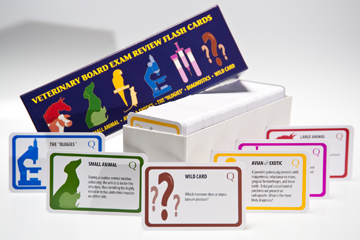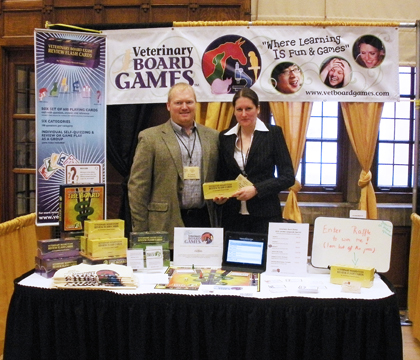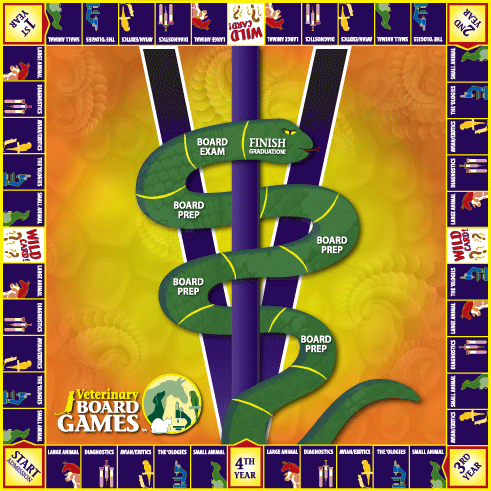
Veterinary game injects fun into studying
Dr. James Montgomery clearly remembers being a senior veterinary student at the University of Prince Edward Island's Atlantic Veterinary College (AVC) and spending hours studying for the North American Veterinary Licensing Examination (NAVLE®).
By Lynne Gunville
Each year, thousands of men and women prepare for the NAVLE® — a rite of passage for all North American veterinarians. In order to practise veterinary medicine, all Canadian and American veterinary graduates must pass this challenging exam that consists of 360 multiple choice questions.
"It's the ultimate event for all students in their fourth year, and as I prepared for it, I kept thinking there must be a way to take all that information and make it more interesting and more palatable," recalls Montgomery, now an assistant professor of medical imaging in the Western College of Veterinary Medicine's Department of Small Animal Clinical Sciences.

The experience got Montgomery thinking about how easy it would be to take the subject areas covered in the veterinary curriculum and transplant them into a game styled similarly to the highly successful Trivial Pursuit board game.
After talking it over with his wife Dr. Julia Montgomery, a specialist in large animal internal medicine, the idea began to fall into place. The couple decided to create an interactive game that would help students absorb all of the information they had learned over four years of veterinary school.
Their first step was to ask for publishing advice from Dr. Etienne Côté, an AVC colleague of theirs who had recently published a textbook, the Clinical Veterinary Advisor: Dogs and Cats.
Côté, who taught James during his DVM program, teaches veterinary cardiology and is well known for using non-traditional teaching methods that make learning fun. Immediately intrigued by the idea, he offered to become involved. The three partners created the company, Veterinary Board Games (VBG), and went to work.
Their first step, inviting people to contribute questions, resulted in the participation of over 60 contributors — a diverse group of veterinarians and veterinary educators from all over the world.

"We tried to find a real mix of people," says James. "We wrote a bunch of questions ourselves and we contacted people that each of us knew from previous jobs and so on — a wide range of perspectives that included specialists as well as individuals who had recently taken the exam."
With hundreds of questions to categorize, the partners then sat down and divided them into six groups: large animal, small animal, avian and exotics, the "-ologies," diagnostics and "wild card" questions.
As they edited the questions, providing answers and bibliographic references for each one, they concentrated on their goals: to weight the categories effectively and to style the questions so students would retain and integrate the information rather than just memorize it.
"We think that integration is important just for being a good veterinarian," James explains. "If you actually understand the pathophysiology of the disease process, for example, then you can interpret diagnostic findings better and apply them in a more practical manner."
Their final product, Veterinary Board Exam Review Flash Cards, was released in 2008. Since then the game has expanded to include three volumes, each consisting of 600 flashcards. The partners are working on a fourth volume that is predominantly image based — a way to address the quantity of images such as microscope slides and X-rays that play such a vital role in veterinary education.
Customers can choose from a number of options aimed at addressing diverse learning styles. While the game board and flashcards can be purchased separately or in various combinations, the flashcards are also available in an online subscription format as well as in an electronic format that includes iPhone, iPad and android apps.
Vanessa Vrolyk, a Master of Science student in WCVM's Department of Veterinary Biomedical Sciences and a senior veterinary student at the Université de Montréal, will challenge the NAVLE® in the late fall of 2012. She and her roommate have purchased a used Volume 1 of the Veterinary Board Exam Review Flash Cards and are using the cards to study together.
In addition to the ease of use and portability of the flash cards, Vrolyk appreciates their bibliographic references that direct her to the specific pages and chapters that can further her understanding of a particular question.
She sees the flash cards as an excellent study tool that can help to reduce the stress of studying by helping students identify and concentrate on the questions that they find difficult. "For me, the best way to judge if I know a subject is by being asked questions. I either know the answer or I don't. Simple!"
But to Vrolyk the most useful aspect of the game is the fact that it includes all species and subjects that are relevant for the NAVLE®.
"When I'm using the VBG flashcards, I know that I'm not losing time studying unnecessary details," she explains. "They provide a precious summary of the important information in all of the different branches of veterinary medicine and can guide my studying so I can save time by targeting the main subjects that must be known in each area."
VBG now has its own website as well as Facebook page, with each one posting "The Question of the Day." To update students on sales and new releases, class representatives have been recruited from over 30 veterinary colleges throughout North America and the Caribbean.
Julia, now a postdoctoral fellow at the WCVM, says she was surprised by the speed with which Volume 1 sold out as the game caught on among students in their earlier years as well as in their final year of veterinary school. She's also gratified to see the number of veterinary schools and universities who have purchased the games and made them available to their students.
"I was amazed by the interest from people all over the world," says Julia. "It's wonderful to see that people are looking for ways to learn this information and are reaching out from all parts of the world."
Although the Montgomerys have no plans to give up their veterinary careers, they agree that producing the game has been a fun project on the side and they feel good about their involvement in it.
"It's the idea that we've created something new that was an unexplored format in veterinary medicine before," explains James.
"And hopefully it's had a positive impact on the students and their experience with board preparation. There's no real way to make it fun, but we hope that the game encourages more interactive learning and helps to relieve some of their stress."
Please visit the Veterinary Board Games web site for more information about the company's products or visit Veterinary Board Games' Facebook page.
"It's the ultimate event for all students in their fourth year, and as I prepared for it, I kept thinking there must be a way to take all that information and make it more interesting and more palatable," recalls Montgomery, now an assistant professor of medical imaging in the Western College of Veterinary Medicine's Department of Small Animal Clinical Sciences.

The experience got Montgomery thinking about how easy it would be to take the subject areas covered in the veterinary curriculum and transplant them into a game styled similarly to the highly successful Trivial Pursuit board game.
After talking it over with his wife Dr. Julia Montgomery, a specialist in large animal internal medicine, the idea began to fall into place. The couple decided to create an interactive game that would help students absorb all of the information they had learned over four years of veterinary school.
Their first step was to ask for publishing advice from Dr. Etienne Côté, an AVC colleague of theirs who had recently published a textbook, the Clinical Veterinary Advisor: Dogs and Cats.
"The NAVLE® is the ultimate event for all students in their fourth year, and as I prepared for it, I kept thinking there must be a way to take all that information and make it more interesting and more palatable."
Côté, who taught James during his DVM program, teaches veterinary cardiology and is well known for using non-traditional teaching methods that make learning fun. Immediately intrigued by the idea, he offered to become involved. The three partners created the company, Veterinary Board Games (VBG), and went to work.
Their first step, inviting people to contribute questions, resulted in the participation of over 60 contributors — a diverse group of veterinarians and veterinary educators from all over the world.

"We tried to find a real mix of people," says James. "We wrote a bunch of questions ourselves and we contacted people that each of us knew from previous jobs and so on — a wide range of perspectives that included specialists as well as individuals who had recently taken the exam."
With hundreds of questions to categorize, the partners then sat down and divided them into six groups: large animal, small animal, avian and exotics, the "-ologies," diagnostics and "wild card" questions.
As they edited the questions, providing answers and bibliographic references for each one, they concentrated on their goals: to weight the categories effectively and to style the questions so students would retain and integrate the information rather than just memorize it.
"We think that integration is important just for being a good veterinarian," James explains. "If you actually understand the pathophysiology of the disease process, for example, then you can interpret diagnostic findings better and apply them in a more practical manner."
Their final product, Veterinary Board Exam Review Flash Cards, was released in 2008. Since then the game has expanded to include three volumes, each consisting of 600 flashcards. The partners are working on a fourth volume that is predominantly image based — a way to address the quantity of images such as microscope slides and X-rays that play such a vital role in veterinary education.
Customers can choose from a number of options aimed at addressing diverse learning styles. While the game board and flashcards can be purchased separately or in various combinations, the flashcards are also available in an online subscription format as well as in an electronic format that includes iPhone, iPad and android apps.
Vanessa Vrolyk, a Master of Science student in WCVM's Department of Veterinary Biomedical Sciences and a senior veterinary student at the Université de Montréal, will challenge the NAVLE® in the late fall of 2012. She and her roommate have purchased a used Volume 1 of the Veterinary Board Exam Review Flash Cards and are using the cards to study together.
In addition to the ease of use and portability of the flash cards, Vrolyk appreciates their bibliographic references that direct her to the specific pages and chapters that can further her understanding of a particular question.
She sees the flash cards as an excellent study tool that can help to reduce the stress of studying by helping students identify and concentrate on the questions that they find difficult. "For me, the best way to judge if I know a subject is by being asked questions. I either know the answer or I don't. Simple!"
But to Vrolyk the most useful aspect of the game is the fact that it includes all species and subjects that are relevant for the NAVLE®.
"When I'm using the VBG flashcards, I know that I'm not losing time studying unnecessary details," she explains. "They provide a precious summary of the important information in all of the different branches of veterinary medicine and can guide my studying so I can save time by targeting the main subjects that must be known in each area."
VBG now has its own website as well as Facebook page, with each one posting "The Question of the Day." To update students on sales and new releases, class representatives have been recruited from over 30 veterinary colleges throughout North America and the Caribbean.
Julia, now a postdoctoral fellow at the WCVM, says she was surprised by the speed with which Volume 1 sold out as the game caught on among students in their earlier years as well as in their final year of veterinary school. She's also gratified to see the number of veterinary schools and universities who have purchased the games and made them available to their students.
"I was amazed by the interest from people all over the world," says Julia. "It's wonderful to see that people are looking for ways to learn this information and are reaching out from all parts of the world."
Although the Montgomerys have no plans to give up their veterinary careers, they agree that producing the game has been a fun project on the side and they feel good about their involvement in it.
"It's the idea that we've created something new that was an unexplored format in veterinary medicine before," explains James.
"And hopefully it's had a positive impact on the students and their experience with board preparation. There's no real way to make it fun, but we hope that the game encourages more interactive learning and helps to relieve some of their stress."
Please visit the Veterinary Board Games web site for more information about the company's products or visit Veterinary Board Games' Facebook page.
